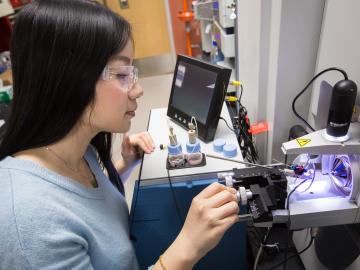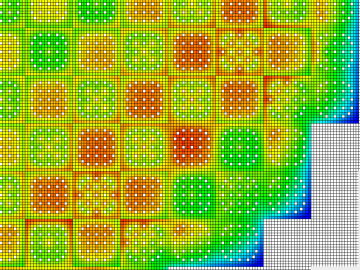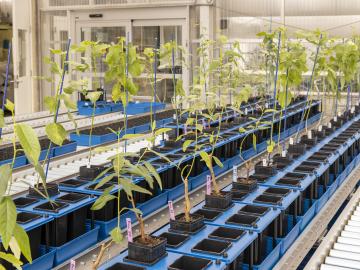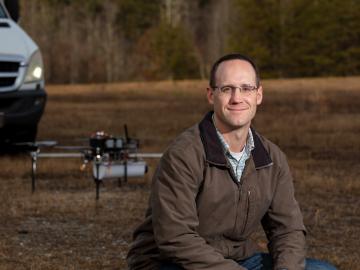
Filter News
Area of Research
- Advanced Manufacturing (6)
- Biological Systems (2)
- Biology and Environment (89)
- Biology and Soft Matter (1)
- Computational Biology (1)
- Computational Engineering (2)
- Computer Science (6)
- Electricity and Smart Grid (1)
- Energy Science (134)
- Fuel Cycle Science and Technology (1)
- Functional Materials for Energy (1)
- Fusion and Fission (12)
- Fusion Energy (7)
- Isotopes (26)
- Materials (54)
- Materials for Computing (10)
- Mathematics (1)
- National Security (52)
- Neutron Science (23)
- Nuclear Science and Technology (17)
- Nuclear Systems Modeling, Simulation and Validation (1)
- Quantum information Science (1)
- Sensors and Controls (1)
- Supercomputing (73)
- Transportation Systems (2)
News Topics
- (-) Advanced Reactors (40)
- (-) Artificial Intelligence (131)
- (-) Bioenergy (112)
- (-) Composites (35)
- (-) Isotopes (62)
- (-) Mathematics (12)
- (-) National Security (86)
- (-) Security (31)
- (-) Software (1)
- (-) Transportation (103)
- 3-D Printing/Advanced Manufacturing (146)
- Big Data (79)
- Biology (128)
- Biomedical (73)
- Biotechnology (39)
- Buildings (74)
- Chemical Sciences (86)
- Clean Water (33)
- Computer Science (226)
- Coronavirus (48)
- Critical Materials (29)
- Cybersecurity (35)
- Education (5)
- Element Discovery (1)
- Emergency (4)
- Energy Storage (114)
- Environment (218)
- Exascale Computing (67)
- Fossil Energy (8)
- Frontier (64)
- Fusion (66)
- Grid (74)
- High-Performance Computing (130)
- Hydropower (12)
- Irradiation (3)
- ITER (9)
- Machine Learning (68)
- Materials (157)
- Materials Science (158)
- Mercury (12)
- Microelectronics (4)
- Microscopy (56)
- Molten Salt (10)
- Nanotechnology (64)
- Neutron Science (171)
- Nuclear Energy (122)
- Partnerships (68)
- Physics (69)
- Polymers (35)
- Quantum Computing (53)
- Quantum Science (93)
- Simulation (65)
- Space Exploration (26)
- Statistics (4)
- Summit (71)
Media Contacts

Radioactive isotopes power some of NASA’s best-known spacecraft. But predicting how radiation emitted from these isotopes might affect nearby materials is tricky

A developing method to gauge the occurrence of a nuclear reactor anomaly has the potential to save millions of dollars.

Systems biologist Paul Abraham uses his fascination with proteins, the molecular machines of nature, to explore new ways to engineer more productive ecosystems and hardier bioenergy crops.

Scientists at Oak Ridge National Laboratory and Ohio State University discovered a new microbial pathway that produces ethylene, providing a potential avenue for biomanufacturing a common component of plastics, adhesives, coolants and other

As CASL ends and transitions to VERA Users Group, ORNL looks at the history of the program and its impact on the nuclear industry.

Oak Ridge National Laboratory researchers have developed artificial intelligence software for powder bed 3D printers that assesses the quality of parts in real time, without the need for expensive characterization equipment.

Scientists at the Department of Energy’s Oak Ridge National Laboratory have a powerful new tool in the quest to produce better plants for biofuels, bioproducts and agriculture.

Horizon31, LLC has exclusively licensed a novel communication system that allows users to reliably operate unmanned vehicles such as drones from anywhere in the world using only an internet connection.

Oak Ridge National Laboratory researchers have developed a machine learning model that could help predict the impact pandemics such as COVID-19 have on fuel demand in the United States.

Oak Ridge National Laboratory scientists evaluating northern peatland responses to environmental change recorded extraordinary fine-root growth with increasing temperatures, indicating that this previously hidden belowground mechanism may play an important role in how carbon-rich peatlands respond to warming.


